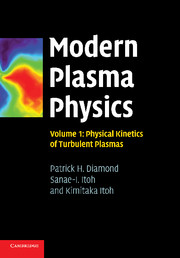Book contents
- Frontmatter
- Contents
- Preface
- Acknowledgements
- 1 Introduction
- 2 Conceptual foundations
- 3 Quasi-linear theory
- 4 Nonlinear wave–particle interaction
- 5 Kinetics of nonlinear wave–wave interaction
- 6 Closure theory
- 7 Disparate scale interactions
- 8 Cascades, structures and transport in phase space turbulence
- 9 MHD turbulence
- Appendix 1 Charney–Hasegawa–Mima equation
- Appendix 2 Nomenclature
- References
- Index
8 - Cascades, structures and transport in phase space turbulence
Published online by Cambridge University Press: 05 October 2010
- Frontmatter
- Contents
- Preface
- Acknowledgements
- 1 Introduction
- 2 Conceptual foundations
- 3 Quasi-linear theory
- 4 Nonlinear wave–particle interaction
- 5 Kinetics of nonlinear wave–wave interaction
- 6 Closure theory
- 7 Disparate scale interactions
- 8 Cascades, structures and transport in phase space turbulence
- 9 MHD turbulence
- Appendix 1 Charney–Hasegawa–Mima equation
- Appendix 2 Nomenclature
- References
- Index
Summary
It is that science does not try to explain, nor searches for interpretations but primarily constructs models. A model is a mathematical construction, which supplemented with some verbal explanation, describes the observed phenomena. Such mathematical construction is proved if and only if it works, that it describes precisely a wide range of phenomena. Furthermore, it has to satisfy certain aesthetic criteria, i.e., it has to be more or less simple compared to the described phenomena.
(J. Von Neumann)Motivation: basic concepts of phase space turbulence
Issues in phase space turbulence
Up to now, our discussion of plasma turbulence has developed by following the two parallel roads shown in Figure 8.1. Following the first, well trodden, path, we have developed the theory of nonlinear mode interaction and turbulence as applied to fundamentally fluid dynamical systems, such as the Navier–Stokes (NS) equation or the quasi-geostrophic (QG) Hasegawa–Mima equation. Along the way, we have developed basic models such as the scaling theory of eddy cascades as in the Kolmogorov theory, the theory of coherent and stochastic wave interactions, renormalized theories of fluid and wave turbulence, the Mori–Zwanzig memory function formalism for elimination of irrelevant variables, and the theory of structure formation in Langmuir turbulence by disparate scale interaction. Following the second, less familiar trail, we have described the theory of kinetic Vlasov turbulence – i.e. turbulence where the fundamental dynamical field is the phase space density f (x, v, t) and the basic equation is the Vlasov equation or one of its gyrokinetic variants.
- Type
- Chapter
- Information
- Modern Plasma Physics , pp. 299 - 347Publisher: Cambridge University PressPrint publication year: 2010

